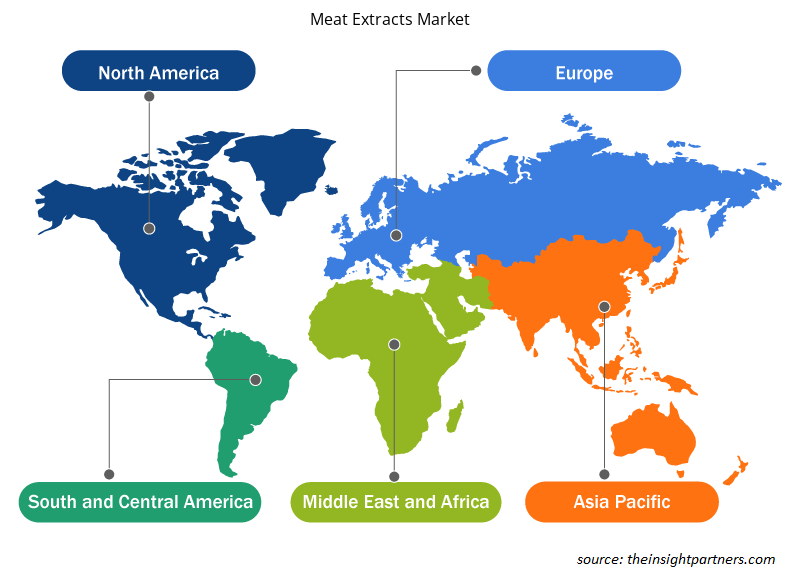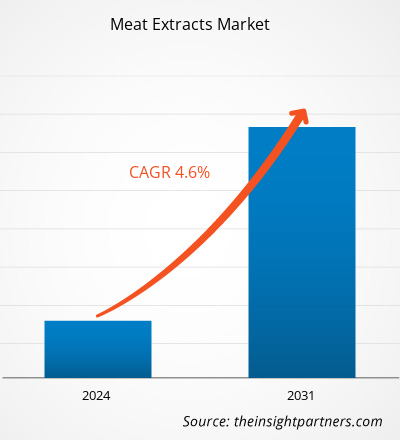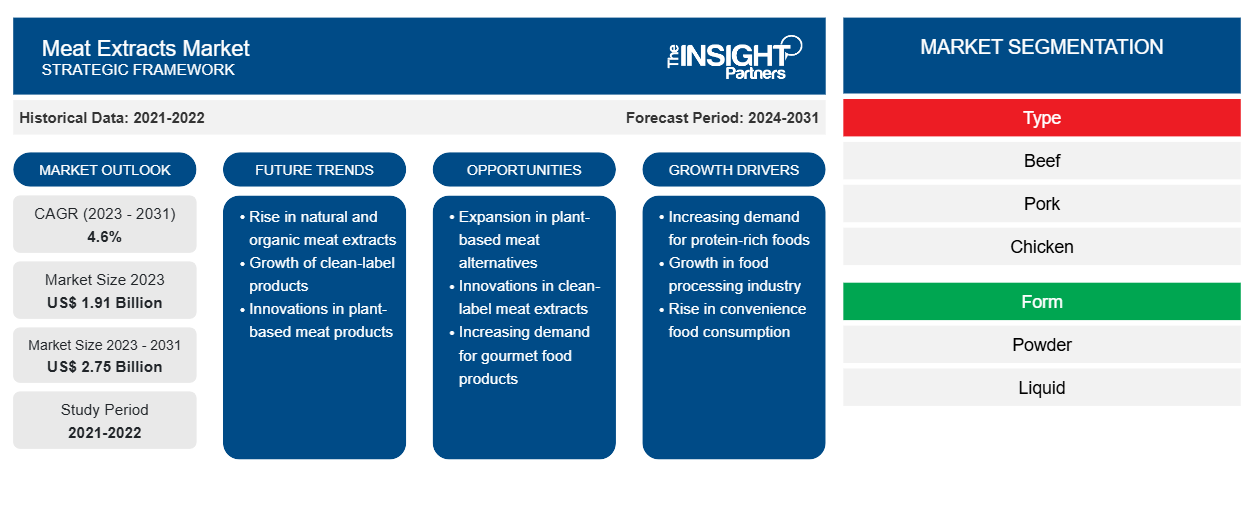Se proyecta que el tamaño del mercado de extractos de carne alcance los 2.750 millones de dólares estadounidenses en 2031, frente a los 1.910 millones de dólares estadounidenses en 2023. Se espera que el mercado registre una CAGR del 4,6 % entre 2023 y 2031. La demanda de proteínas ha aumentado significativamente y muchos consumidores se centran en la salud y el bienestar. Los consumidores no pueden satisfacer sus necesidades dietéticas diarias debido a un estilo de vida agitado y a horarios de trabajo prolongados. Por lo tanto, eligen productos funcionales que contengan proteínas, vitaminas, minerales y carbohidratos buenos.CAGR of 4.6% in 2023–2031. The demand for protein has increased significantly, with many consumers focusing on health and wellness. Consumers cannot achieve their daily dietary requirements owing to a hectic lifestyle and prolonged work schedules. Therefore, they choose functional products containing high proteins, vitamins, minerals, and good carbs.
Análisis del mercado de extractos de carne
El extracto de carne es una materia prima que ayuda al cultivo artificial de microorganismos, utilizado principalmente para el cultivo bacteriano y la fermentación. Se elabora a partir de la descomposición enzimática controlada de carne de alta calidad, generalmente de vacuno. Es una excelente fuente de nutrientes como creatina, creatinina, ácidos orgánicos, aminoácidos solubles en agua, nucleótidos, polipéptidos y minerales y vitaminas que favorecen el crecimiento de microorganismos en medios nutritivos. El polvo de extracto de carne aporta carbono, nitrógeno y energía a los microorganismos, lo que les permite crecer y reproducirse de forma óptima. Los extractos de carne se elaboran a partir de tejidos animales específicos que aumentan el valor nutricional del medio de cultivo. A menudo se utiliza en concentraciones que van del 0,2 % al 1,0 %.creatine, creatinine, organic acids, water-soluble amino acids, nucleotides, polypeptides, and minerals & vitamins that support the growth of microorganisms on nutrient media. Meat extract powder supplies carbon, nitrogen, and energy to the microorganisms, allowing them to grow and reproduce optimally. Meat extracts are made from specific animal tissues that increase the nutritional value of the culture medium. It is often used in concentrations ranging from 0.2% to 1.0%.
Descripción general del mercado de extractos de carne
El extracto de carne está disponible en formato líquido y en polvo. Los extractos de carne líquidos se elaboran hirviendo pequeños trozos de carne en agua y concentrando el líquido para lograr la consistencia deseada. El extracto de carne en polvo se puede obtener secando los trozos de carne cocidos y luego moliéndolos hasta convertirlos en polvo fino. Los fabricantes de bocadillos de carne, sopas y salsas utilizan extractos de carne para añadir un sabor característico a los productos. Además, aumentan el contenido proteico del producto, lo que aumenta su atractivo entre los consumidores preocupados por la salud. Los extractos de carne se utilizan ampliamente para preparar medios de cultivo que se utilizan para cultivar diferentes microorganismos. Los extractos de carne son ricos en proteínas, aminoácidos, peptonas, nucleótidos, entre otros nutrientes que favorecen el crecimiento y la reproducción de microorganismos a un ritmo óptimo. Además, los extractos de carne se utilizan para desarrollar carne cultivada en laboratorios.
Personalice este informe según sus necesidades
Obtendrá personalización en cualquier informe, sin cargo, incluidas partes de este informe o análisis a nivel de país, paquete de datos de Excel, así como también grandes ofertas y descuentos para empresas emergentes y universidades.
-
Obtenga las principales tendencias clave del mercado de este informe.Esta muestra GRATUITA incluirá análisis de datos, desde tendencias del mercado hasta estimaciones y pronósticos.
Factores impulsores y oportunidades del mercado de extractos de carne
La creciente demanda de extractos de carne como potenciadores del sabor favorecerá el mercado
En los últimos años, la producción y el consumo de carne han aumentado significativamente con el aumento de la población mundial, el aumento del número de familias de ingresos medios y la creciente demanda de alimentos asequibles y con alto contenido de proteínas. La carne de ave es uno de los principales impulsores del crecimiento de la industria cárnica, ya que es una fuente asequible de proteínas y se considera más saludable que otras carnes como la de vacuno y la de cerdo. Según las estadísticas de la Organización para la Cooperación y el Desarrollo Económicos y la Organización de las Naciones Unidas para la Alimentación y la Agricultura, se espera que la producción mundial de carne alcance los 373 millones de toneladas en 2030. Además, se espera que el consumo de carne per cápita en todo el mundo alcance los 43,7 kg de peso corporal real (expresado en peso al por menor).capita meat consumption across the globe is expected to reach 43.7 kg rwt (expressed in retail weight).
Demanda creciente de extractos de carne orgánicos y de etiqueta limpia: una oportunidad
Los consumidores están muy preocupados por los alimentos que consumen. Están prestando más atención a las etiquetas de los productos y a los ingredientes utilizados en los alimentos procesados. Los productos orgánicos son cada vez más populares debido a sus beneficios percibidos para la salud. No contienen pesticidas, fertilizantes químicos ni organismos genéticamente modificados (OGM), lo que aumenta su atractivo entre los consumidores, que están dispuestos a pagar precios altos. Además, los consumidores prefieren cada vez más productos cárnicos de etiqueta limpia, libres de sabores sintéticos , colorantes y otros aditivos alimentarios. Además, los consumidores se centran en el consumo holístico y consciente y prefieren productos con ingredientes de origen ético.GMOs) that increase their appeal among consumers, who are ready to pay high prices. Moreover, consumers increasingly prefer clean-label meat products free of synthetic
Análisis de segmentación del informe de mercado de extractos de carne
Los segmentos clave que contribuyeron a la derivación del análisis del mercado de extractos de carne son el tipo, la forma, la aplicación y el usuario final.
- Según el tipo, el mercado de extractos de carne se divide en carne de res, de cerdo, de pollo y otros. El segmento de carne de res tuvo una mayor participación de mercado en 2023.
- Por forma, el mercado se segmenta en polvo, líquido y otros. El segmento de polvos tuvo la mayor participación del mercado en 2023.
- En términos de aplicación, el mercado se divide en comidas listas para comer y listas para consumir, bocadillos dulces y salados, sopas y salsas, entre otros. El segmento Otros dominó el mercado en 2023.
Análisis de la cuota de mercado de extractos de carne por geografía
El alcance geográfico del informe del mercado de extractos de carne se divide principalmente en cinco regiones: América del Norte, Asia Pacífico, Europa, Medio Oriente y África, y América del Sur / América del Sur y Central.
El mercado de extractos de carne ha dominado en América del Norte. Esta región es una de las más importantes debido al creciente consumo de productos a base de carne como alimentos saludables y ricos en proteínas. Estados Unidos es el mayor exportador de carne de ave del mundo y un importante productor de huevos. La creciente preferencia de los consumidores por opciones de carne más magra, junto con los cambios en los patrones dietéticos, impulsa la demanda de carne de pollo en la región. Además, los consumidores de países como Estados Unidos y Canadá han comenzado a optar por productos a base de carne, incluido el tocino, en lugar de otras opciones para el desayuno, como los panqueques, debido a la voluntad de probar nuevos productos. El extracto de carne también se utiliza en la preparación de medios de cultivo. Por ejemplo, Hardy Diagnostics es una empresa estadounidense que fabrica y vende medios de cultivo bacteriológicos. Preparan polvo de extracto de carne y lo estandarizan para su uso en medios de cultivo microbiológicos, donde generalmente se utiliza para reemplazar las infusiones de carne. Durante muchos años, los medios de extracto de carne se han recomendado como estándar para su uso en el examen bacteriológico de rutina del agua, la leche y otros materiales.
Perspectivas regionales del mercado de extractos de carne
Los analistas de Insight Partners explicaron en detalle las tendencias y los factores regionales que influyen en el mercado de extractos de carne durante el período de pronóstico. Esta sección también analiza los segmentos y la geografía del mercado de extractos de carne en América del Norte, Europa, Asia Pacífico, Oriente Medio y África, y América del Sur y Central.

- Obtenga datos regionales específicos para el mercado de extractos de carne
Alcance del informe de mercado de extractos de carne
| Atributo del informe | Detalles |
|---|---|
| Tamaño del mercado en 2023 | 1.910 millones de dólares estadounidenses |
| Tamaño del mercado en 2031 | US$ 2,75 mil millones |
| CAGR global (2023 - 2031) | 4,6% |
| Datos históricos | 2021-2022 |
| Período de pronóstico | 2024-2031 |
| Segmentos cubiertos |
Por tipo
|
| Regiones y países cubiertos |
América del norte
|
| Líderes del mercado y perfiles de empresas clave |
|
Densidad de actores del mercado: comprensión de su impacto en la dinámica empresarial
El mercado de extractos de carne está creciendo rápidamente, impulsado por la creciente demanda de los usuarios finales debido a factores como la evolución de las preferencias de los consumidores, los avances tecnológicos y una mayor conciencia de los beneficios del producto. A medida que aumenta la demanda, las empresas amplían sus ofertas, innovan para satisfacer las necesidades de los consumidores y aprovechan las tendencias emergentes, lo que impulsa aún más el crecimiento del mercado.
La densidad de actores del mercado se refiere a la distribución de las empresas o firmas que operan dentro de un mercado o industria en particular. Indica cuántos competidores (actores del mercado) están presentes en un espacio de mercado determinado en relación con su tamaño o valor total de mercado.
Las principales empresas que operan en el mercado de extractos de carne son:
- Ingredientes de Colin
- Sabor natural de Carnad
- Grupo Diana
- Ingredientes de PT Foodex Inti
- Givaudan SA
Descargo de responsabilidad : Las empresas enumeradas anteriormente no están clasificadas en ningún orden particular.

- Obtenga una descripción general de los principales actores clave del mercado de extractos de carne
Noticias y desarrollos recientes del mercado de extractos de carne
El mercado de extractos de carne se evalúa mediante la recopilación de datos cualitativos y cuantitativos posteriores a la investigación primaria y secundaria, que incluye publicaciones corporativas importantes, datos de asociaciones y bases de datos. A continuación, se incluye una lista de los avances en el mercado de trastornos del habla y el lenguaje y las estrategias:
En junio de 2021, Essentia Protein Solutions presentó una nueva incorporación a su línea ProFlavor llamada C3307 Chicken Flavor. Esta última opción de sabor ofrece varios beneficios, incluido un mayor contenido de proteínas, niveles reducidos de carbohidratos y sin sal adicional. Está diseñada específicamente para ayudar en la creación de productos con menor contenido de sodio y, al mismo tiempo, brindar un sabor a pollo fuerte y auténtico. (Fuente: Essentia Protein Solutions/sitio web de la empresa)
Informe de mercado sobre extractos de carne: cobertura y resultados
El informe “Tamaño y pronóstico del mercado de extractos de carne (2021-2031)” proporciona un análisis detallado del mercado que cubre las siguientes áreas:
- Tamaño del mercado y pronóstico a nivel global, regional y nacional para todos los segmentos clave del mercado cubiertos bajo el alcance
- Dinámica del mercado, como impulsores, restricciones y oportunidades clave
- Principales tendencias futuras
- Análisis detallado de las cinco fuerzas de Porter y PEST y FODA
- Análisis del mercado global y regional que cubre las tendencias clave del mercado, los principales actores, las regulaciones y los desarrollos recientes del mercado.
- Análisis del panorama de la industria y de la competencia que abarca la concentración del mercado, el análisis de mapas de calor, los actores destacados y los desarrollos recientes
- Perfiles detallados de empresas
- Análisis histórico (2 años), año base, pronóstico (7 años) con CAGR
- Análisis PEST y FODA
- Tamaño del mercado, valor/volumen: global, regional y nacional
- Industria y panorama competitivo
- Conjunto de datos de Excel
Informes recientes
Informes relacionados
Testimonios
Razón para comprar
- Toma de decisiones informada
- Comprensión de la dinámica del mercado
- Análisis competitivo
- Información sobre clientes
- Pronósticos del mercado
- Mitigación de riesgos
- Planificación estratégica
- Justificación de la inversión
- Identificación de mercados emergentes
- Mejora de las estrategias de marketing
- Impulso de la eficiencia operativa
- Alineación con las tendencias regulatorias























 Obtenga una muestra gratuita para - Mercado de extractos de carne
Obtenga una muestra gratuita para - Mercado de extractos de carne